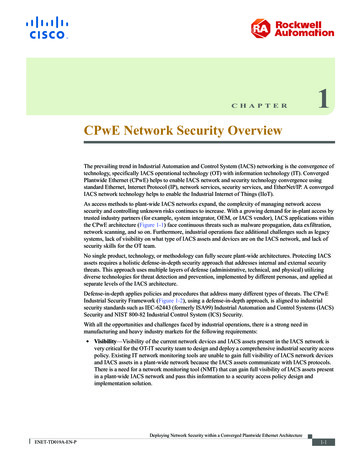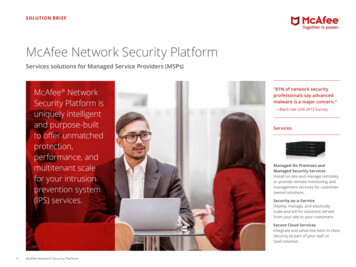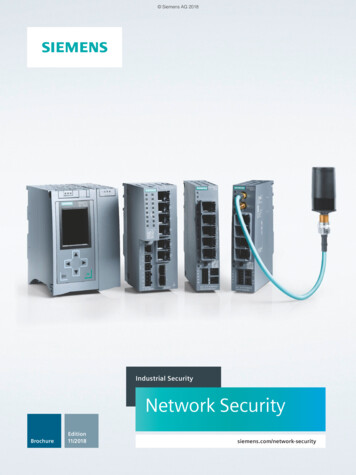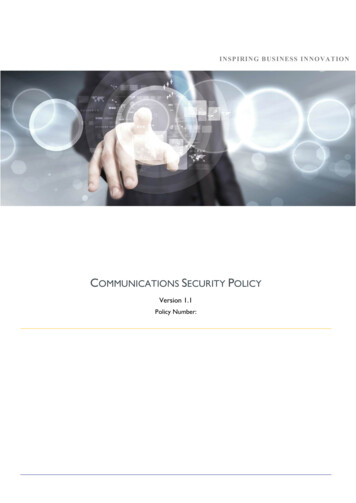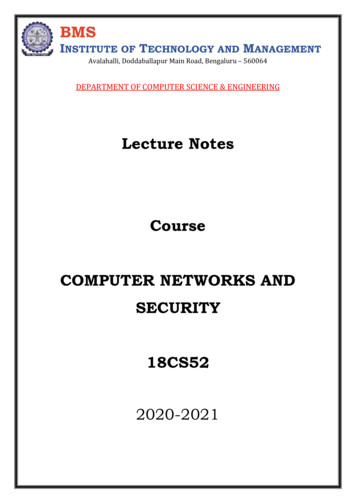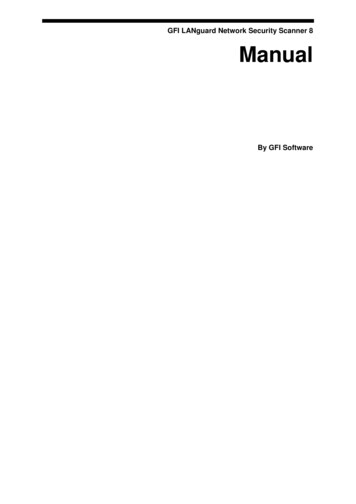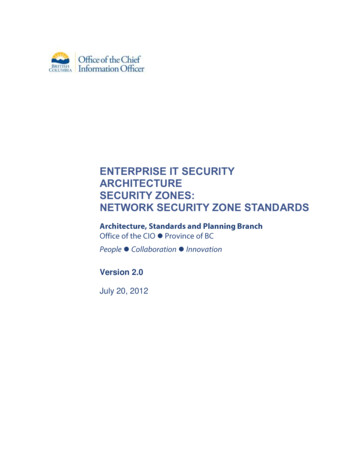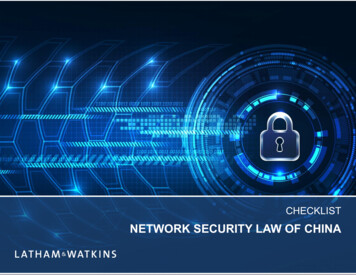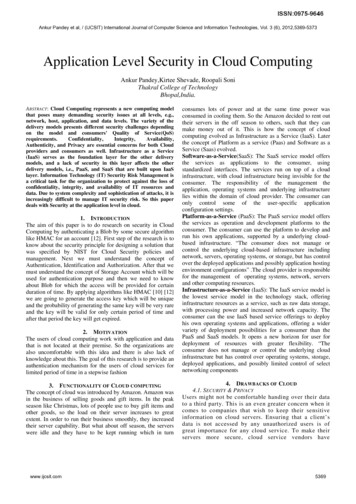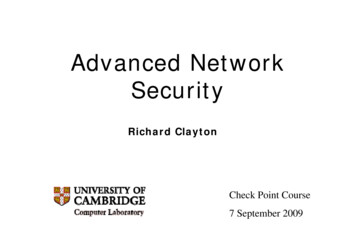
Transcription
Advanced NetworkSecurityRichard ClaytonCheck Point Course7 SeptemberS t b 2009
Overview Is the infrastructure secure ?– attacks on DNS– attacks on BGP ISP log processing– usingg heuristics to detect email spamp7th September 2009Advanced Network Security
All your mailserverare belong to us
CAUTIONThis talk describes possible attacks on Internet infrastructure,especially DNS & BGP. But, not all of these attacks workeverywhere, and people may be reluctant to discuss whetherthey work or not in their part of the real world.So don’t assume it’s all entirely true!However, it isnisn’tt entirely false either!Any mention I make of particular networks, ISPs or countriesi merelyisl to makek abstractbideasidconcrete, not an analysisl i offactual flaws.NB: Doo noto tryy anya y ofo this ata homeo(OR(O ata work)o )7th September 2009Advanced Network Security
Threat scenario I wish to capture a significant amount of incomingemail to a major ISP mail server––––email may contain passwords etcemail can be made to contain passwords etcanswering email often “proves” identityobvious opportunity to blackmail the ISP, or just trashtheirhreputation as beingbsecure Attack should “scale” to many ISPs– 0-day0 day exploit on sendmaild il not considered here7th September 2009Advanced Network Security
Resources Back bedroom attackers– can now have control of a reasonable size botnet Criminal entrepreneurs– may own (or 0wn!) a smallish ISP in Ruritania Organised crime ?– simpler for them just to bribe an employee! I am NOT assuming that BGP or DNS are tooobscure to be attacked effectivelyy7th September 2009Advanced Network Security
Underlying strategies Cannot just steal packets – people notice– cf YouTube outage in February 2008 (Pakistan Telecom) Accept email, resend to the correct ISP– top 50 senders is a give-away,give-away so use botnet Reject email end of data with a 4xx response– email generally rere-delivereddelivered after a delay, so suitable forintermittent attacks Tunnel SMTP packets to correct place– either a peer of target or customer within target7th September 2009Advanced Network Security
DNS (I): active attacks DNS server asks for data– attacker supplies incorrect answer first 16 bit identifier is not long enough! but, modern software randomises request port Older software is flawed– predictable random numbers! or even accepts non-authorised data! No-one monitors for attacks– howeverhthisthi scalesl bbadly,dl so off lilimitedit d iinteresttt– BUT WAIT!7th September 2009Advanced Network Security
DNS (II): Kaminsky Ask for multiple sub-domains (sub1, sub2 etc.)– neat way of ensuring resolver always has to ask Attacker tries to get their answer in first– BUT of course only poisons some obscure sub-domain Kaminsky realised could supply NS data as well– “in-bailiwick”in bailiwick data (extra info from authoritative server)– relied upon for some purposes! So devastating attack! Mitigateg((only)y) with lots of entropypy (as( before))– and what of clever servers behind dumb firewalls?– only real fix is DNSSEC7th September 2009Advanced Network Security
DNS (III): phishing “Rock-phish” gang spoofed GoDaddy Aug07– probably just wanted some cheap domains– BUT control of a registrar account permits changes toname server identities Registrars for grown-ups will check validity ofchanges out-of-band, 10 hosting will not– significant number of US banks were vulnerable Attack vector might also be malware 7th September 2009Advanced Network Security
DNS (IV): root of trust 13 top level name servers (A-M)– maximum that will fit in a DNS response Included with BIND (etc) as a text file– you have to start bootstrapping somewhere! L moved from 198.32.64.12 to 199.7.83.42– moved 1 Nov 2007 (warnings sent 24 Oct 2007)– AS20144 (ICANN) announced route until 2 May 2008 BUT other AS’s announced route– Dec 15 (AS42909), Mar 18 (AS 4555), Apr 1 (AS9584)– all serving the right thing (through May, we think!)7th September 2009Advanced Network Security
Attacks on BGP Basic idea: announce a /32 for mailserver– BGP prefers a “more specific” announcement Traffic then flows to Ruritania– email contents are available for inspection /32 may not propagate, so /24 may be better– leads to complexity if other hosts or services on /24– hence tunnelling packets back to ISP may be best (andjust sniff them as they pass) Sniffing possible anyway at other ISPs– difference here is scale and remoteness7th September 2009Advanced Network Security
More specifics Route should not be accepted– mntmnt-lowerlower prevents creation of new route objects– so everyone ought to notice that route isn’t valid– complexities with multiple registries Route may be spotted by monitoring– MyASNy@ RIPE,, Renesysy etc– note that bogon filtering hides route from owner! and soBest Practice prevents give-away failures7th September 2009Advanced Network Security
Unauthorised announcements Existing route: hope to be a shorter AS path– BGP counts AS’s to determine preference– so more effective in Ruritania than London May help to forge origin for peer to accept theroute (entirely dependent on filters) Once again, monitoring detects wickedness– but registry data error-prone and incomplete so canperhaps only consider changes?– and of course you need to know all about multi-homedcustomers! Is this possible?7th September 2009Advanced Network Security
More BGP Stuff RIPEMyASN & lots of other initiatives Experimental alerting s unm edu/alerts phphttp://phas.netsec.colostate.edu Anirudh Ramachandran and Nick FeamsterSIGCOMM 2006: Understanding theNetwork-Level Behavior of Spammers7th September 2009Advanced Network Security
SMTP Defence I: encryption Opportunistic encryption (RFC3207)– uses STARTTLS capability & command– negotiate mutually acceptable algorithm Plus points:– works out of the box for major MTAs– onlyy end-pointspcan decryptyp the traffic Minus points:– increases processing load (may not matter)– no “man-in-the-middle” protection7th September 2009Advanced Network Security
SMTP Defence II: authentication Check certificates before sending email– prevents man-in-the-middleman in the middle Plus points:– works out of the box for major MTAs Minus points:– increases processing load (albeit may not matter)– needs a Public Key Infrastructure (or a lot of bilateralarrangements)7th September 2009Advanced Network Security
Network level defences Anti-spoofing filters on customer links– motherhood! (but tedious for custom customers) Much harder to do on border routers– unicast reverse path forwarding (RPF) can help– but at IXPs this may not be practicable Can check if traffic coming from correct peer– straightforward(ish) sFlow/Netflow analysis7th September 2009Advanced Network Security
Secure DNS/BGP Secure DNS almost here– some TLDs already signed,signed more to come– unlikely that will be fully deployed for years– BUT Kaminsky exploit has given it a huge boost Secure BGP(s)( ) experimentalpat ppresent– concerns about performance (cf MD5)– concerns about key distribution– when will it be stable and inter-working?7th September 2009Advanced Network Security
Blended attacks Some key distribution schemes use DNS AttackAtt k theth DNS andd you may beb ablebl totcompromise systems that are “secure” Best use of a BGP attack may be to capture theDNS servers (think long TTL), and then you cango after the mail servers at leisure! and of course you may just want to DoS– so yyou don’t mind if youryattack is noticed7th September 2009Advanced Network Security
ButBt whyh nott jjusttattack the customerdirectly?
Customer equipment Windows machines may keep name serveridentities in registry – easy for malware to change But in practice, usually set by DHCP Hence only need to compromise home routers––––maymaymaymayhave no password at all (and insecure wireless)be configurable from “thethe outside”outsidebe insecure, with buffer overflows &cstill have the standard password With wireless as well, some researchers postulatean out-of-band worm!7th September 2009Advanced Network Security
Negligence The failure to use reasonable care CurrentCt ttestt forf “duty“d t off care”:”– harm must be (1) reasonably foreseeable(2) there must be a relationship of proximity betweenthe plaintiff and defendant and(3) it must be “fair, just and reasonable” to imposeliability If one of my attacks is effective on a mailserver,because of firewall failings, are you negligent? Short term specific: if your router/firewall makespredictable,, are youynegligent?g gDNS IP-IDs p7th September 2009Advanced Network Security
Looking for spamin ISP logs
Email “spam” : key insight Lots of spam is to ancient email addresses LotsL t off spam iis tto inventedit d addressesdd Lots of spam is blocked by remote filters Can process server logs to pick out thisinformation Spam has many delivery failuresinformation.whereas legitimate email mainly works7th September 2009Advanced Network Security
spammercustomertyahoo.comcustomercustomerISP emailserverhotmail team7th September 2009ComplaintsAdvanced Network Security
Log processing heuristics Report “too many” failures to deliver– more than 20 works pretty well Ignore “bounces” !– have null “ ” return path,path these often fail– detect rejection daemons without paths Ignore “mailingmailing lists”lists (fixed sender)– most destinations work, only some fail (10%)– more than one “mailing list” is a spam indicator! Ignore “forwarding” (fixed destination)– multiple forwarding destinations is common7th September 2009Advanced Network Security
Bonus! also detects viruses Common for mass mailing “worms” to useaddress book (mainly valid addresses)– though worms are currently rather out of fashion Often remote sites will reject malwareAND, VERY USEFUL!AND Virus authors don’t know how to say HELO So virus infections are also detected– out of fashion, but many still getting infected7th September 2009Advanced Network Security
2007-05-19 10:47:15 vzjwcqk0n@msa.hinet.netSize 2199!!! 0930456496@yahoo.com!!! 09365874588@fdf.sdfads!!! 0939155631@yahoo.com.yw- 0931244221@fetnet.net- 0932132625@pchome.com.tw2007-05-19 10:50:22 985eubg@msa.hinet.netSize 2206!!! cy-i88222@ms.cy.edw.tw88222@!!! cynthia0421@1111.com.tw- cy.tung@msa.hinet.net- cy3219@hotmail.com3219@h t il- cy chiang@hotmail.com- cyc.aa508@msa.hinet.netand 31 more valid destinations2007-05-19 10:59:15 4uzdcr@msa.hinet.netSize 2228!!! peter@syzygia.com.tw- peterpeter.y@seed.net.twy@seed net tw- peter.zr.kuo@foxconn.com- peter548@ms37.hinet.net- peter62514@yahoo.com.tw- peter740916@yahoo.com.tw7th September 2009Advanced Network Securityand 44 more valid destinations
HELO lrhnow.usa.net2007-05-19 23:11:22 kwntefsqhi@usa.net- ken@example1.demon.co.ukSize 8339HELO lkrw.hotmail.com2007-05-19 23:11:24 zmjkuzzs@hotmail.com- ken@example2.demon.co.ukSize 11340HELO pshw.netscape.net2007 05 19 23:14:52 etnetSize 6122- steve.xf@example3.demon.co.ukHELO zmgpzmgp.cs.comcs com2007-05-19 23:18:06 wmqjympdr@cs.com- kroll@example4.demon.co.uk7th September 2009Size 6925Advanced Network Security
ISP email handlingSmarthostTh InternetTheIMX host7th September 2009Advanced Network Security
Incoming email Some spam runs will also target other customers– complex for spammers to avoid this Some spammers try and use the smarthost, butusing the MX record doesn’tdoesn t work too well– major ISPs don’t do “in” and “out” on the same machine Hence processing incoming server logs can locatethe spammers who don’t use the smarthost– heuristics can in fact be set much more sensitively– once again, good at spotting virus activity7th September 2009Advanced Network Security
Email log processing @ demonDetection of spam (black) and viruses (red)7th September 2009Advanced Network Security
Incoming reports (all sources)spam (black), viruses (red), reports (blue)7th September 2009Advanced Network Security
Traffic analysis This is a specific example of a general techniquecalled “traffictraffic analysis”analysis which permits analysis ofactivity without access to the content The spooks have done it for ages,ages but is nowgetting significant traction in open community This leads to an even more general principle:“It’sIt s hard to make one thing look like anotheranother”especially when attacker doesn’t know exactly (for yourchosen measurement) what “normal” looks like7th September 2009Advanced Network Security
Advanced NetworkSecurityRichard Claytonhttp://www lightbluetouchpaper orghttp://www.lightbluetouchpaper.orgCheck Point Course7 SeptemberS t b 2009
Route may be spotted by monitoring -Myy,yASN @ RIPE, Renesys etc - note that bogon filtering hides route from owner! and so . 7th September 2009 Advanced Network Security peter62514@yahoo.com.tw- peter740916@yahoo.com.tw and 44 more valid destinations. HELO lrhnow.usa.net
